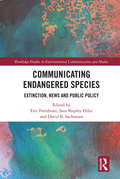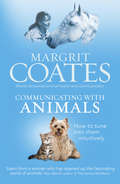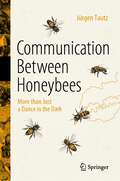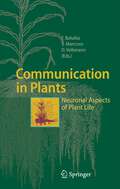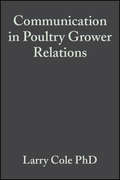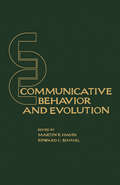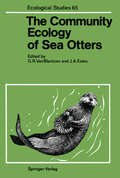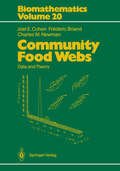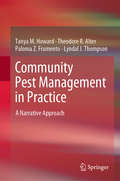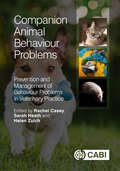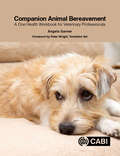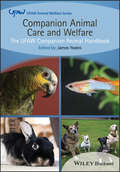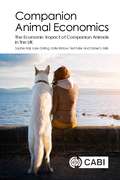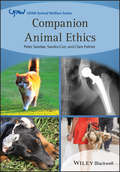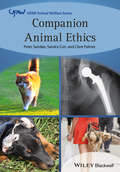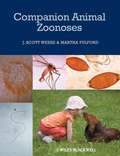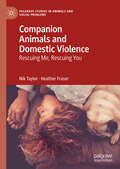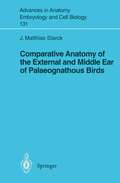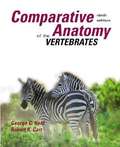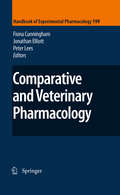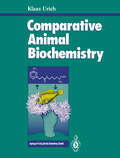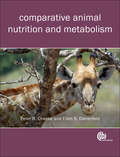- Table View
- List View
Communicating Endangered Species: Extinction, News and Public Policy (Routledge Studies in Environmental Communication and Media)
by Eric Freedman; Sara Shipley Hiles; David B. SachsmanCommunicating Endangered Species: Extinction, News, and Public Policy is a multidisciplinary environmental communication book that takes a distinctive approach by connecting how media and culture depict and explain endangered species with how policymakers and natural resource managers can or do respond to these challenges in practical terms. Extinction isn’t new. However, the pace of extinction is accelerating globally. The International Union for Conservation of Nature classifies more than 26,000 species as threatened. The causes are many, including climate change, overdevelopment, human exploitation, disease, overhunting, habitat destruction, and predators. The willingness and the ability of ordinary people, governments, scientists, nongovernmental organizations, and businesses to slow this deeply disturbing acceleration are uncertain. Meanwhile, researchers around the world are laboring to better understand and communicate the possibility and implications of extinctions and to discover effective tools and public policies to combat the threats to species survival. This book presents a history of news coverage of endangered species around the world, examining how and why journalists and other communicators wrote what they did, how attitudes have changed, and why they have changed. It draws on the latest research by chapter authors who are a mix of social scientists, communication experts, and natural scientists. Each chapter includes a mass media and/or cultural aspect. This book will be essential reading for students, natural resource managers, government officials, environmental activists, and academics interested in conservation and biodiversity, environmental communication and journalism, and public policy.
Communicating Endangered Species: Extinction, News and Public Policy (Routledge Studies in Environmental Communication and Media)
by Eric Freedman Sara Shipley Hiles David B. SachsmanCommunicating Endangered Species: Extinction, News, and Public Policy is a multidisciplinary environmental communication book that takes a distinctive approach by connecting how media and culture depict and explain endangered species with how policymakers and natural resource managers can or do respond to these challenges in practical terms. Extinction isn’t new. However, the pace of extinction is accelerating globally. The International Union for Conservation of Nature classifies more than 26,000 species as threatened. The causes are many, including climate change, overdevelopment, human exploitation, disease, overhunting, habitat destruction, and predators. The willingness and the ability of ordinary people, governments, scientists, nongovernmental organizations, and businesses to slow this deeply disturbing acceleration are uncertain. Meanwhile, researchers around the world are laboring to better understand and communicate the possibility and implications of extinctions and to discover effective tools and public policies to combat the threats to species survival. This book presents a history of news coverage of endangered species around the world, examining how and why journalists and other communicators wrote what they did, how attitudes have changed, and why they have changed. It draws on the latest research by chapter authors who are a mix of social scientists, communication experts, and natural scientists. Each chapter includes a mass media and/or cultural aspect. This book will be essential reading for students, natural resource managers, government officials, environmental activists, and academics interested in conservation and biodiversity, environmental communication and journalism, and public policy.
Communicating with Animals: How to tune into them intuitively
by Margrit CoatesMargrit Coates's new book is essential reading for anyone who loves animals and who wishes to improve their understanding of animal behaviour. One of the world's leading animal communicators and healers, Margrit has many years' experience working closely with species of all kinds - from horses, dogs and cats, to wild life, rare breeds and rescue animals. In Communicating with Animals, she draws upon her very special gift and amazing experiences to help us connect with animals too. Using intuition, insight and common sense, she shows how to tune into what they are really thinking and feeling, helping us bond with them at an incredibly deep level. Her powerful techniques range from communicating with the furry, feathered and scaly friends who share our homes, to larger animals such as horses and even Anne the Elephant, as well as other non-domestic creatures. Ultimately, Margrit's wish is for each one of us to be able to tune into all life around us. Besides practical exercises and handy tips, Communicating with Animals is brimming with heart-warming stories - making it a great read and a truly inspirational guide.
Communication Between Honeybees: More than Just a Dance in the Dark
by Jürgen TautzJürgen Tautz, renowned German bee researcher explains how bees communicate. Exciting and surprising new insights on communication between bees. During the history of bee research, scientists have peered deep into the inner life of bee colonies and learned much about the behaviour of these insects. Above all, the bee waggle dance has become a famous and extensively discussed phenomenon. Nevertheless, recent insights reveal that while bees are social insects inside the hive they also communicate with one another outside the hive. In this book, Jürgen Tautz, renowned German bee researcher, provides an entertaining, fresh and enlightened account for lay and professional readers, not only about the fascinating dance language but also about additional remarkable phenomena concerning information exchange between bees. From the author of the bestseller “The Buzz about Bees”. “The Language of Bees” assembles, for the first time, a complete overview of how bees understand one another. Although communication biology research on bees has so far concentrated largely on events within the hive, this book directs attention as well, to how bees communicate in the field outside the hive. The reader learns which steps new bee recruits take to reach the feeder a dancing forager has advertised. The book analyses the status of work on the bee dance published over the last 100 years and orders the essential findings as building blocks into a coherent new concept of how bees find their target. In addition, the historical survey of research on the “Bee Language” explains how several contradictory and incomplete hypotheses can still survive. A fresh point of view on one of the most remarkable behavioural performances in the animal kingdom. Observation from a different viewpoint leads to previously unknown insights. Such new perspectives clearly reveal both how large the gaps in our knowledge still are in relation to the language of bees and in which direction research must take to complete the picture of one of the most impressive behavioural accomplishments in animals. Prof. Dr. Jürgen Tautz is an expert on bees, sociobiologist, animal behaviourist and emeritus professor at the Biozentrum, University of Würzburg. He is a bestseller author and recipient of many awards of excellence for his successful communication of science to a wide public.
Communication in Plants: Neuronal Aspects of Plant Life
by Frantisek Baluska Stefano Mancuso Dieter VolkmannPlant neurobiology is a newly emerging field of plant sciences. It covers signalling and communication at all levels of biological organization – from molecules up to ecological communities. In this book, plants are presented as intelligent and social organisms with complex forms of communication and information processing. Authors from diverse backgrounds such as molecular and cellular biology, electrophysiology, as well as ecology treat the most important aspects of plant communication, including the plant immune system, abilities of plants to recognize self, signal transduction, receptors, plant neurotransmitters and plant neurophysiology. Further, plants are able to recognize the identity of herbivores and organize the defence responses accordingly. The similarities in animal and plant neuronal/immune systems are discussed too. All these hidden aspects of plant life and behaviour will stimulate further intense investigations in order to understand the communicative plants in their whole complexity.
Communication in Poultry Grower Relations: A Blueprint to Success
by Larry ColeCommunication in Poultry Grower Relations shows a process used to continuously improve the working relationship between integrators and their growers. A special feature is the "how to" format in which this book details the relationship process so a company and its growers can implement the procedures discussed. The book also provides a comprehensive discussion on the dynamics associated with corporate culture changes. The reader will learn how to manage the resistance associated with each of the five phases of change to successfully implement the improvements in the company-grower working relationship.
Communicative Behavior and Evolution
by Martin E. Hahn Edward C. SimmelCommunicative Behavior and Evolution presents the selected works of experts from different scientific disciplines that investigate the evolution of communicative behavior. The book is composed of papers that study communicative behavior of humans and of different kinds of animals. The text contains articles that discuss attempts in the study of behavioral evolution; communication and human language; the behavior-genetic approach; systems approach to genetic and selection mechanisms; investigation of interspecific communication; and learned language in chimpanzees. Zoologists, ethologists, behavioral geneticists, and psychologists will find this book highly interesting.
The Community Ecology of Sea Otters (Ecological Studies #65)
by Glenn R. VanBlaricom James A. EstesThe impetus for this volume comes from two sources. The first is scientific: by virtue of a preference for certain large benthic invertebrates as food, sea otters have interesting and significant effects on the structure and dynamics of nearshore communities in the North Pacific. The second is political: be cause of the precarious status of the sea otter population in coastal California, the U.S. Fish and Wildlife Service (USFWS) announced, in June 1984, a proposal to establish a new population of sea otters at San Nicolas Island, off southern California. The proposal is based on the premise that risks of catastrophic losses of sea otters, due to large oil spills, are greatly reduced by distributing the population among two geographically separate locations. The federal laws of the U.S. require that USFWS publish an Environmental Impact Statement (ElS) regarding the proposed translocation of sea otters to San Nicolas Island. The EIS is intended to be an assessment of likely bio logical, social, and economic effects of the proposal. In final form, the EIS has an important role in the decision of federal management authority (in this case, the Secretary of the Interior of the U.S.) to accept or reject the proposal.
Community Food Webs: Data and Theory (Biomathematics #20)
by Joel E. Cohen Frederic Briand Charles M. NewmanFood webs hold a central place in ecology. They describe which organisms feed on which others in natural habitats. This book describes recently discovered empirical regularities in real food webs: it proposes a novel theory unifying many of these regularities, as well as extensive empirical data. After a general introduction, reviewing the empirical and theoretical discoveries about food webs, the second portion of the book shows that community food webs obey several striking phenomenological regularities. Some of these unify, regardless of habitat. Others differentiate, showing that habitat significantly influences structure. The third portion of the book presents a theoretical analysis of some of the unifying empirical regularities. The fourth portion of the book presents 13 community food webs. Collected from scattered sources and carefully edited, they are the empirical basis for the results in the volume. The largest available set of data on community food webs provides a valuable foundation for future studies of community food webs. The book is intended for graduate students, teachers and researchers primarily in ecology. The theoretical portions of the book provide materials useful to teachers of applied combinatorics, in particular, random graphs. Researchers in random graphs will find here unsolved mathematical problems.
Community Pest Management in Practice: A Narrative Approach
by Tanya M. Howard Theodore R. Alter Paloma Z. Frumento Lyndal J. ThompsonThis book presents a collection of practitioner and community stories that reveal how invasive species management is a community issue that can spark community formation and collective action. It combines the unique first-person narratives of practitioners on the frontline of invasive species management in Australia with three case studies of community action for wild dog management across a range of geographical landscapes. The book offers readers a new understanding of how communities are formed in the context of managing different species, and how fundamental social and political processes can make or break landholders’ ability to manage invasive species. Using narrative analysis of practitioner profiles and community groups, drawing lessons from real-world practices, and employing theories from community development, rural sociology and collective action, this book serves multiple functions: it offers a teaching tool, a valuable research contribution, and a practitioner’s field guide to pursuing effective community development work in connection with natural resource management, wildlife management and environmental governance.
Companion Animal Behaviour Problems: Prevention and Management of Behaviour Problems in Veterinary Practice
by David Ryan Jon Bowen Emma Lightfoot Dr Anne McBride Clare Wilson Caroline Bower Francesca Riccomini Claire Hargrave David Appleby Emily Blackwell Julie Bedford Caroline Warnes Trudi Atkinson Emma Brown Amanda Roshier Stephanie HedgesBehaviour problems are a significant cause of companion animal relinquishment and euthanasia. This book provides up to date information about animal behaviour as well as practical advice on how veterinary practice professionals can manage undesirable animal behaviour and give down to earth, appropriate and trusted advice to owners. This book: · Covers the important aspects of behaviour in dogs, cats, rabbits and rodents, parrots and birds, as well as how this behaviour has adapted to the domestic environment. · Discusses the role of the veterinary practice in improving the emotional experience of animals attending the veterinary practice, including practice design, socialisation classes for young animals and effective communication with owners. · Covers the clinical decision-making process in managing the signs of undesirable behaviour, appropriately handling pets in the practice to minimise distress, as well as: behavioural first aid, referral to a specialist, medical influences on behaviour and decisions about euthanasia. This practical and accessible book gives all the essential information needed by veterinary professionals in order to advise clients on the behaviour and well-being of animals in their care.
Companion Animal Bereavement: A One Health Workbook for Veterinary Professionals
by Angela GarnerThis concise workbook is written as a guide for veterinary professionals to support owners through the many challenges they face before, during and after the death of their companion animal. This unique text provides a wealth of practical advice to be used when supporting both adults and children through the grief process. It offers support when discussing subjects such as natural death versus euthanasia and guiding owners through after death services. Also, it covers the difficulties experienced by owners due to separation for other reasons, such as when a pet has to be rehomed. The book: - Gives highly practical guidance on pet bereavement support for vet staff before, during and after animal loss, including communicating with highly distressed people; - Includes exercises and activities which can be downloaded and shared with owners to help them cope with the destabilising effects of grief; - Helps gain a deeper understanding of the owners' perceptions of the process, including their fears and feelings; - Addresses the importance of self-care and peer support within the veterinary team or animal welfare organisation; - Contains numerous case studies and practical examples in the book and via additional online resources.
Companion Animal Care and Welfare: The UFAW Companion Animal Handbook (Wiley-ASME Press Series)
by James YeatesCompanion Animal Care and Welfare: The UFAW Companion Animal Handbook presents a comprehensive, accessible and practical reference for all parties seeking information about the proper care of companion animals. Identifies the needs of companion animals, explains how we know these needs, and gives scientifically-backed advice on how to meet these needs Promotes the most humane treatment and best possible care of our companion animals Addresses controversial issues such as selective breeding, companion animal showing, the keeping of exotic species, and the international pet trade Covers the husbandry and care of all major companion animal species, including mammals, birds, fish, reptiles and amphibians
Companion Animal Care and Welfare: The UFAW Companion Animal Handbook (UFAW Animal Welfare)
by James YeatesCompanion Animal Care and Welfare: The UFAW Companion Animal Handbook presents a comprehensive, accessible and practical reference for all parties seeking information about the proper care of companion animals. Identifies the needs of companion animals, explains how we know these needs, and gives scientifically-backed advice on how to meet these needs Promotes the most humane treatment and best possible care of our companion animals Addresses controversial issues such as selective breeding, companion animal showing, the keeping of exotic species, and the international pet trade Covers the husbandry and care of all major companion animal species, including mammals, birds, fish, reptiles and amphibians
Companion Animal Economics: The Economic Impact of Companion Animals in the UK (CABI Concise)
by Dr Sophie S Hall Luke Dolling Katie Bristow Professor Ted Fuller Professor Daniel MillsSuccinct, highly readable and thought provoking, this important new text is designed to raise awareness of the potential economic impact of companion animals in the UK. It discusses the potential benefits and costs of companion animals to the economy and highlights the need for this matter to be thoroughly researched, given the potential scale of impact and the potential costs of ignoring this matter. The book includes: - case studies to illustrate the savings to the NHS that might be associated with companion animal ownership; - links to up-to-date tables and content that might form templates for use in other countries; and - highly readable information written by expert authors and key opinion leaders in the field. Inspired by the seminal Council for Science and Society (CSS) Report, Companion Animals in Society (1988), this work updates and extends its evaluation of the economic impact of companion animals on society and lays a benchmark for future development. This pivotal new book is important for policy makers at national and international levels and all those involved in animal welfare.
Companion Animal Ethics (UFAW Animal Welfare)
by Peter Sandøe Sandra Corr Clare PalmerCompanion Animal Ethics explores the important ethical questions and problems that arise as a result of humans keeping animals as companions. The first comprehensive book dedicated to ethical and welfare concerns surrounding companion animals Scholarly but still written in an accessible and engaging style Considers the idea of animal companionship and why it should matter ethically Explores problems associated with animals sharing human lifestyles and homes, such as obesity, behavior issues, selective breeding, over-treatment, abandonment, euthanasia and environmental impacts Offers insights into practical ways of improving ethical standards relating to animal companions
Companion Animal Ethics (UFAW Animal Welfare)
by Peter Sandøe Sandra Corr Clare PalmerCompanion Animal Ethics explores the important ethical questions and problems that arise as a result of humans keeping animals as companions. The first comprehensive book dedicated to ethical and welfare concerns surrounding companion animals Scholarly but still written in an accessible and engaging style Considers the idea of animal companionship and why it should matter ethically Explores problems associated with animals sharing human lifestyles and homes, such as obesity, behavior issues, selective breeding, over-treatment, abandonment, euthanasia and environmental impacts Offers insights into practical ways of improving ethical standards relating to animal companions
Companion Animal Zoonoses
by J. Scott Weese Martha FulfordCompanion Animal Zoonoses is a comprehensive resource on diseases transmissible between animals and humans. Presenting detailed prevention and control strategies for zoonotic diseases, the book is an in-depth guide to practical information on the spread of disease between pet animals and humans. This relevant work provides up-to-date information on emerging issues, disease incidence and risk, and management measures. Covering the complete range of companion animal zoonoses, each topic begins with information on etiology, geographic distribution, epidemiology, and pathophysiology. The discussion then moves into clinical presentation, diagnosis, and management, alongside prevention information for both animals and humans. Companion Animal Zoonoses is an essential reference for practicing veterinarians, public health veterinarians, and veterinary students. It will also appeal to physicians who wish to better understand zoonotic diseases.
Companion Animals and Domestic Violence: Rescuing Me, Rescuing You (Palgrave Studies in Animals and Social Problems)
by Nik Taylor Heather FraserIn this book, Nik Taylor and Heather Fraser consider how we might better understand human-animal companionship in the context of domestic violence. The authors advocate an intersectional feminist understanding, drawing on a variety of data from numerous projects they have conducted with people, about their companion animals and links between domestic violence and animal abuse, arguing for a new understanding that enables animals to be constituted as victims of domestic violence in their own right. The chapters analyse the mutual, loving connections that can be formed across species, and in households where there is domestic violence. Companion Animals and Domestic Violence also speaks to the potentially soothing, healing and recovery oriented aspects of human-companion animal relationships before, during and after the violence, and will be of interest to various academic disciplines including social work, anthropology, sociology, philosophy, geography, as well as to professionals working in domestic violence or animal welfare service provision.
Comparative Anatomy of the External and Middle Ear of Palaeognathous Birds (Advances in Anatomy, Embryology and Cell Biology #131)
by J.Matthias StarckComparative Anatomy Of The Vertebrates (PDF)
by George C. Kent Robert K. CarrDeemed a classic for its reading level and high-quality illustrations, this respected text is ideal for your one-semester Comparative Anatomy course. For the ninth edition, George Kent is joined by new co-author Bob Carr.
Comparative and Veterinary Pharmacology (Handbook of Experimental Pharmacology #199)
by Fiona Cunningham Jonathan Elliott Peter LeesThe human–animal bond has evolved and diversi?ed down the ages. Dogs, cats and even horses, have long ful?lled the role of faithful companion and indeed, as exempli?ed by the introduction of seeing and hearing dogs, there may be a critical level of co-dependency between the species. In the twenty-?rst century, the animal types that are kept as pets in many parts of the world are extensive ranging from reptiles through rodents to ruminants and beyond. As would be predicted by the nature of the relationship, the approach to treatment of a companion animal is often closely aligned to that which would have been offered to their owner. However, an increasing awareness of welfare issues, such as the recognition that animals expe- ence pain and the proven bene?ts of disease prevention in intensive farming units, together with the growth in zoos and wildlife parks, has increased the likelihood of food producing and non-domesticated animals receiving medicinal products during their life-time. Although many of the individual drugs or classes of drugs administered to animals are the same as, or derived from, those given to man, the safe and effective use of drugs in animals often cannot be achieved by simply transposing knowledge of drug action on, or behaviour in, the body from one species to another. The impact of the anatomical, physiological and pathophysiological variability that spans the animal kingdom can often profoundly alter drug response.
Comparative Animal Biochemistry
by Klaus Urichtribute greatly to understanding the origins of The plan for this book goes back almost 20 years. Already, at that time, it was possible to recognize organisms. an extraordinary variation in metabolites and To provide the biochemist with a ready over processes superimposed upon the basic biochem view of the structural diversity of animals, the book includes a simplified version of animal sys ical system of animals. Each species, each indi tematics; for further information on the classifica vidual, in fact each type of cell of the multicellu lar organism possesses its own biochemical char tion, structure and life of particular animal spe acter, and this molecular variety, its biological sig cies, the reader should consult the relevant text nificance, and its evolutionary development books. It is assumed that the zoologist reader has throw up many interesting questions. The com a basic knowledge of biochemistry; important general biochemical facts are in any case given for parative approach that has been so productive at many of the subjects covered. the higher levels of complexity of morphology and physiology can also be used to great effect at I had already completed several chapters of the molecular level. this book by the beginning of the 1970s.
Comparative Animal Nutrition and Metabolism
by Peter Cheeke Ellen DierenfeldNutrition is a very broad discipline, encompassing biochemistry, physiology, endocrinology, immunology, microbiology and pathology. Presenting the major principles of nutrition of both domestic and wild animals, this book takes a comparative approach, recognising that there are considerable differences in nutrient digestion, metabolism and requirements among various mammalian and avian species. Explaining species differences in food selection, food-seeking and digestive strategies and their significance to nutritional needs, chapters cover a broad range of topics including digestive physiology, metabolic disorders and specific nutrients such as carbohydrates proteins and lipids, with particular attention being paid to nutritional and metabolic idiosyncrasies. It is an essential text for students of animal and veterinary sciences.
Comparative Animal Nutrition and Metabolism (PDF)
by Peter Cheeke Ellen DierenfeldNutrition is a very broad discipline, encompassing biochemistry, physiology, endocrinology, immunology, microbiology and pathology. Presenting the major principles of nutrition of both domestic and wild animals, this book takes a comparative approach, recognising that there are considerable differences in nutrient digestion, metabolism and requirements among various mammalian and avian species. Explaining species differences in food selection, food-seeking and digestive strategies and their significance to nutritional needs, chapters cover a broad range of topics including digestive physiology, metabolic disorders and specific nutrients such as carbohydrates proteins and lipids, with particular attention being paid to nutritional and metabolic idiosyncrasies. It is an essential text for students of animal and veterinary sciences.
